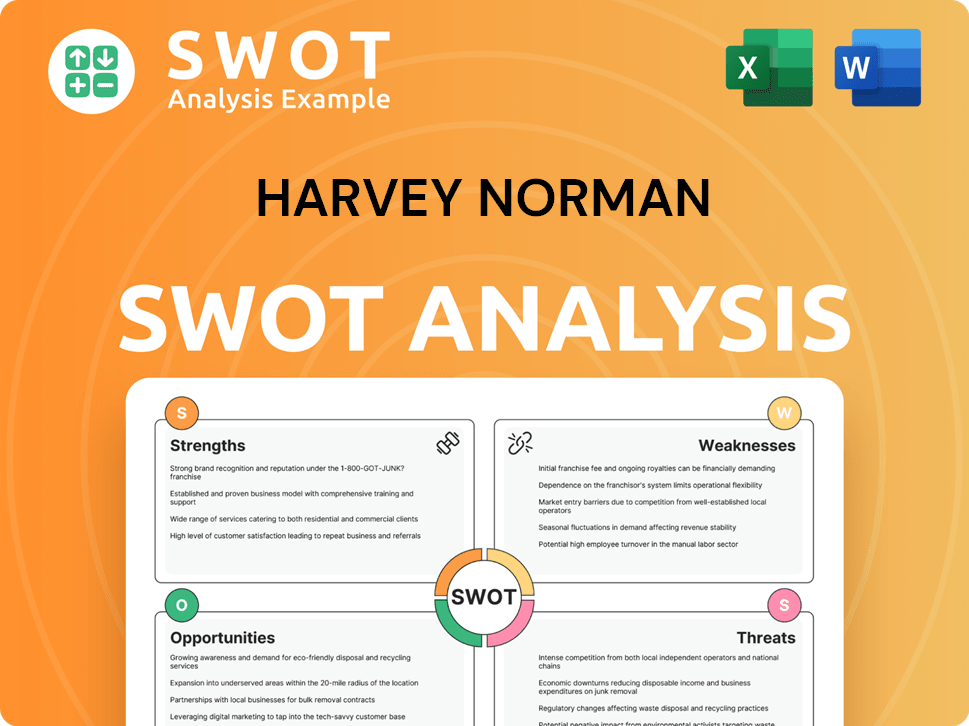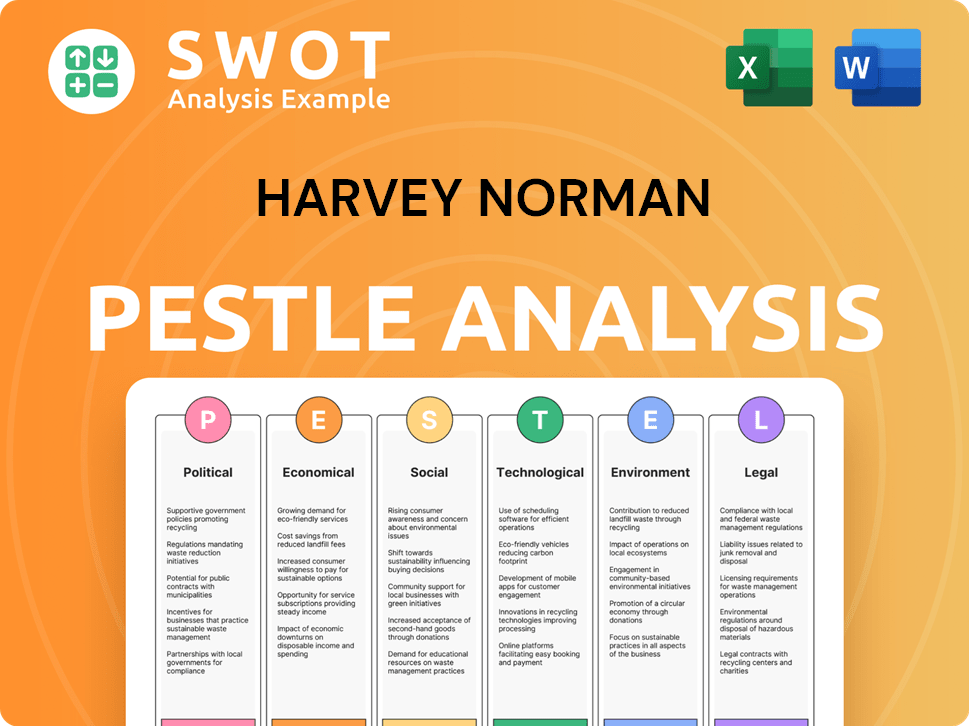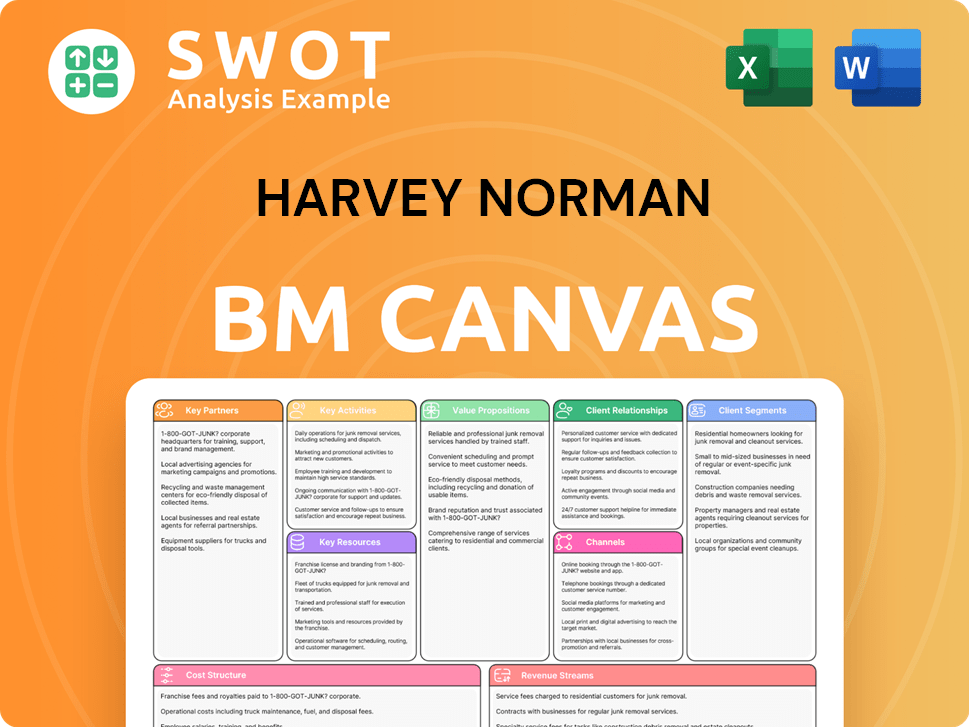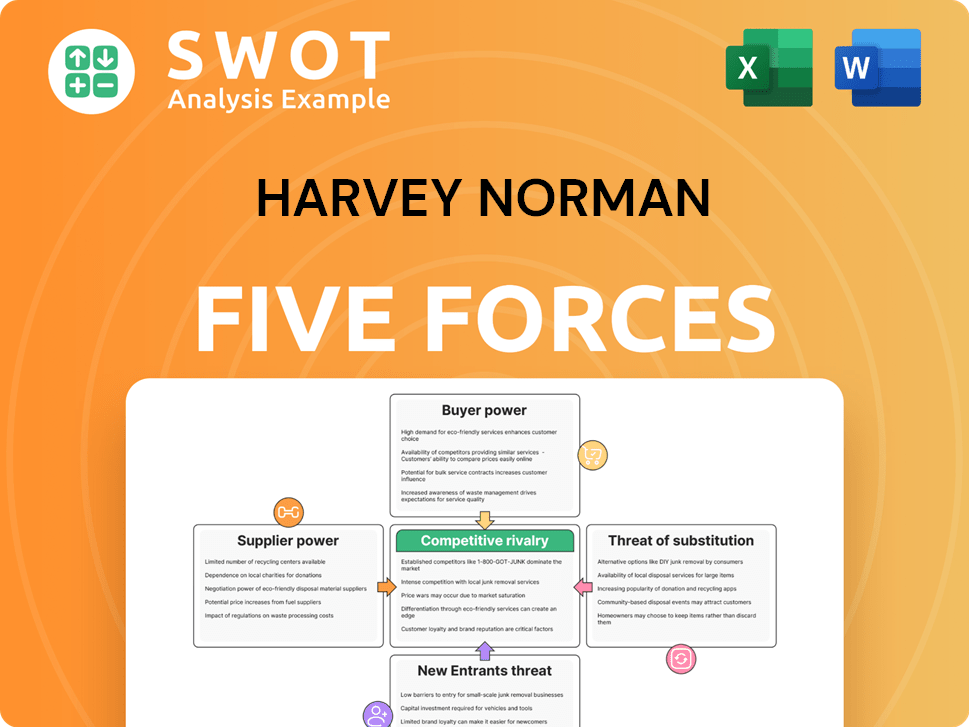Harvey Norman Bundle
How did Harvey Norman become a Retail Titan?
Journey back in time to uncover the Harvey Norman SWOT Analysis, a story of Australian retail innovation. From a single electrical goods store to a global powerhouse, Harvey Norman's history is a testament to strategic vision and market adaptation. Explore the key milestones that shaped the Harvey Norman company, its founder Gerry Harvey, and its impact on the Australian retail landscape.

The brief history of Harvey Norman reveals a fascinating evolution from a local business to a multinational corporation. Understanding the Harvey Norman founding date and early years provides crucial context for its later successes. This exploration of Harvey Norman's business model and expansion timeline offers valuable insights into its enduring presence in the competitive retail sector.
What is the Harvey Norman Founding Story?
The story of the Harvey Norman company began in 1961. Gerry Harvey and Ian Norman, who initially worked together selling vacuum cleaners, opened their first retail store in Sydney. This marked the start of what would become a major player in Australian retail.
Their initial store focused on selling electrical goods and appliances. The success of this venture led to expansion and a partnership with Keith Lord, forming the Norman Ross retail chain. By 1979, Norman Ross had grown substantially, operating 42 stores with sales exceeding $240 million.
In October 1982, Gerry Harvey and Ian Norman bought a shopping center in Auburn, Sydney, for A$3 million. They opened the first Harvey Norman store there. The plan was initially for a single store, but its immediate success led to further expansion. Harvey Norman Holdings Limited was listed on the Australian Securities Exchange on September 3, 1987.
The early business model of Harvey Norman centered on offering quality electrical goods and appliances at competitive prices. They provided exceptional customer service and innovative payment options, such as interest-free finance.
- The first store opened in 1982 in Auburn, Sydney.
- The company was listed on the Australian Securities Exchange in 1987.
- The focus was on electrical goods, appliances, and furniture.
- Interest-free finance was a key strategy to boost sales.
The original strategy included offering interest-free finance, which made big-ticket items more accessible to customers. This approach significantly boosted sales, helping the company grow rapidly. Gerry Harvey, despite initially aiming to be a farmer, became a key figure in sales. Together with Ian Norman, they built a strong foundation for Harvey Norman to become a well-known name. The company expanded its product range over time, including furniture, bedding, and other home goods.
As of 2024, Harvey Norman operates a large number of stores across Australia and internationally. The company has adapted its business model to include online sales and other modern retail strategies. The company has faced various challenges, including economic downturns and changes in consumer behavior, but it has remained a significant player in the Australian retail market.
Harvey Norman SWOT Analysis
- Complete SWOT Breakdown
- Fully Customizable
- Editable in Excel & Word
- Professional Formatting
- Investor-Ready Format

What Drove the Early Growth of Harvey Norman?
The early 1990s marked a significant turning point for the Harvey Norman company, as it adopted the 'superstore' format and expanded its product offerings. This strategic shift, coupled with key acquisitions and international ventures, fueled rapid growth. By the early 2000s, the company had established a strong presence in the Australian retail landscape and began its global expansion.
In the early 1990s, the company adopted the 'superstore' model, which had proven successful in the United States. This format allowed for the display of a wider range of products. The first computer superstore opened in Bennetts Green, Newcastle, in late 1993, followed by a larger store in Auburn. This expansion into computers and furniture broadened the customer base.
The company's expansion was driven by a combination of organic growth and strategic acquisitions. By 2000, the company's network had surpassed 100 stores. Key acquisitions, such as Joyce Mayne and several electrical stores in Western Australia, further solidified its market position. In 2006, the acquisition of struggling Retravision stores provided additional growth opportunities.
International expansion became a key focus. The first store in New Zealand opened in 1997, and by 2025, there were over 46 stores. The company entered Asia through a joint venture, Harvey Norman Ossia (Asia) Pte Ltd, and opened stores in Singapore, Slovenia, Ireland, and Malaysia. By 2024, there were 117 overseas company-owned stores.
The company's unique franchise model, where it owned and leased properties to franchisees, generated multiple revenue streams. The company embraced e-commerce in 2011, recognizing the shift in consumer behavior. This move aimed to establish a digitally enabled omni-channel strategy, adapting to evolving market trends.
Harvey Norman PESTLE Analysis
- Covers All 6 PESTLE Categories
- No Research Needed – Save Hours of Work
- Built by Experts, Trusted by Consultants
- Instant Download, Ready to Use
- 100% Editable, Fully Customizable

What are the key Milestones in Harvey Norman history?
The story of Harvey Norman, a prominent player in Retail Australia, is marked by significant milestones that have shaped its journey. From its founding to its current status, the company has adapted to market changes and expanded its footprint. Understanding the Harvey Norman company's evolution provides insights into its strategies and impact on the retail landscape.
| Year | Milestone |
|---|---|
| 1982 | Established by Gerry Harvey and Ian Norman, marking the beginning of the Harvey Norman story. |
| Early 1990s | Pioneered the 'superstore' format, broadening its product range to include computers and furniture. |
| 2011 | Launched its e-commerce platform, expanding its reach to online customers. |
| February 2025 | Reported investment in AI for home automation and experimenting with augmented reality apps. |
| 2024 | Partnerships with organizations like Good360 Australia for community engagement. |
Harvey Norman has consistently embraced innovations to stay ahead in the competitive retail market. A key innovation was the adoption of the superstore model, which allowed for a wide array of products. Furthermore, the company's continuous investment in digital transformation and AI, as of February 2025, shows its commitment to adapting to technological advancements.
Early adoption of the 'superstore' format in the 1990s, which allowed for a broader product range. This format distinguished Harvey Norman from competitors by offering a diverse selection of goods, including computers and furniture.
The unique franchise model, where the company owns the property and leases it to franchisees, has been a cornerstone of its success. This model provides multiple revenue streams and fosters entrepreneurial leadership at the store level.
Launched its e-commerce presence in 2011, expanding its reach to online customers. This move was crucial in adapting to changing consumer behavior and the rise of online shopping.
Continuous investment in digital transformation to enhance its omni-channel capabilities. This includes investments in AI for home automation and augmented reality apps, demonstrating a commitment to staying at the forefront of retail technology.
Robust supply chain and relationships with top brands ensure a meticulously curated product range and competitive pricing. Partnerships, such as those with Good360 Australia for their 2024 EveryOne Day campaign, further demonstrate their adaptability and community engagement.
Investing in AI for home automation and experimenting with augmented reality apps to tailor online purchases. This shows a proactive approach to enhancing customer experience and staying competitive in the digital age.
Despite its successes, Harvey Norman has faced several challenges in the dynamic Australian retail environment. Intense competition from both traditional and online retailers, like Amazon, has pressured its market share. Economic downturns and shifts in consumer spending also pose risks to profitability.
Intense competition from both traditional brick-and-mortar retailers and online giants like Amazon. This requires constant adaptation and innovation to maintain market share and customer loyalty.
Economic downturns and fluctuations in consumer spending pose a threat to profitability. These economic factors can significantly impact sales and overall financial performance.
The rapid growth of internet research and price comparisons can impact its brick-and-mortar sales. Consumers can easily compare prices online, which can affect in-store sales and pricing strategies.
While its property portfolio is substantial, valued at AU$4.14 billion in February 2025, some analysts suggest that capital could be better reinvested in growth opportunities or shareholder returns rather than property ownership. Rising interest rates potentially impact property valuations.
Addressing challenges through strategic modernizations, enhancing digital and in-store experiences, and expanding its global store network. This includes partnerships and community engagement initiatives to stay relevant.
Maintaining market share in a competitive environment requires continuous innovation and adaptation. The company has to constantly evolve its strategies to meet changing consumer demands and competitive pressures.
For more details on the company's values and mission, you can read the mission, vision, and core values of Harvey Norman.
Harvey Norman Business Model Canvas
- Complete 9-Block Business Model Canvas
- Effortlessly Communicate Your Business Strategy
- Investor-Ready BMC Format
- 100% Editable and Customizable
- Clear and Structured Layout

What is the Timeline of Key Events for Harvey Norman?
The history of Harvey Norman is marked by significant milestones. Gerry Harvey and Ian Norman initiated their journey in 1961, establishing a foundation that would evolve into a major player in the Australian retail sector. The company's evolution showcases its adaptability and strategic foresight in response to market trends and consumer demands.
| Year | Key Event |
|---|---|
| 1961 | Gerry Harvey and Ian Norman opened their first store, specializing in electrical goods and appliances. |
| 1982 | The first Harvey Norman store opened in Auburn, Sydney, after selling their stake in Norman Ross. |
| 1987 | Harvey Norman Holdings Limited was listed on the Australian Securities Exchange. |
| 1993 | The first computer superstore opened in Bennetts Green, Newcastle. |
| 1997 | Harvey Norman expanded internationally, opening its first store in New Zealand. |
| 2001 | Gained majority control of the Rebel Sport retail chain. |
| 2011 | Launched its e-commerce presence. |
| 2015 | Opened its flagship store in Millenia Walk, Singapore. |
| 2024 (February) | Reported revenue of A$4.11 billion and net income of A$357.62 million. |
| 2025 (February) | Reported a profit before tax of $400.29 million for the first half of the 2025 financial year. |
Harvey Norman is focused on modernizing its retail approach, integrating physical and digital interactions within its stores. This includes renovations of flagship stores to enhance customer experience. The company is also experimenting with augmented reality to personalize online purchases.
The company is aiming to expand its retail footprint in emerging regions such as Malaysia and New Zealand. This expansion is part of a broader strategy to increase market share and capitalize on growth opportunities in key international markets. Continued expansion is a key part of the Harvey Norman business model.
Enhancing its e-commerce capabilities is a priority, with the company investing in digital tools to improve online shopping. This includes the use of augmented reality applications to personalize the online shopping experience. The company's e-commerce strategy is designed to complement its physical store network.
With the Reserve Bank of Australia predicting interest rate reductions in 2025, discretionary consumer spending is expected to strengthen. Harvey Norman's leadership anticipates continued sales growth in key product categories, including home appliances and technology. The company's market capitalization grew by 14.10% to AU$6.45 billion.
Harvey Norman Porter's Five Forces Analysis
- Covers All 5 Competitive Forces in Detail
- Structured for Consultants, Students, and Founders
- 100% Editable in Microsoft Word & Excel
- Instant Digital Download – Use Immediately
- Compatible with Mac & PC – Fully Unlocked

Related Blogs
- What is Competitive Landscape of Harvey Norman Company?
- What is Growth Strategy and Future Prospects of Harvey Norman Company?
- How Does Harvey Norman Company Work?
- What is Sales and Marketing Strategy of Harvey Norman Company?
- What is Brief History of Harvey Norman Company?
- Who Owns Harvey Norman Company?
- What is Customer Demographics and Target Market of Harvey Norman Company?
Disclaimer
All information, articles, and product details provided on this website are for general informational and educational purposes only. We do not claim any ownership over, nor do we intend to infringe upon, any trademarks, copyrights, logos, brand names, or other intellectual property mentioned or depicted on this site. Such intellectual property remains the property of its respective owners, and any references here are made solely for identification or informational purposes, without implying any affiliation, endorsement, or partnership.
We make no representations or warranties, express or implied, regarding the accuracy, completeness, or suitability of any content or products presented. Nothing on this website should be construed as legal, tax, investment, financial, medical, or other professional advice. In addition, no part of this site—including articles or product references—constitutes a solicitation, recommendation, endorsement, advertisement, or offer to buy or sell any securities, franchises, or other financial instruments, particularly in jurisdictions where such activity would be unlawful.
All content is of a general nature and may not address the specific circumstances of any individual or entity. It is not a substitute for professional advice or services. Any actions you take based on the information provided here are strictly at your own risk. You accept full responsibility for any decisions or outcomes arising from your use of this website and agree to release us from any liability in connection with your use of, or reliance upon, the content or products found herein.